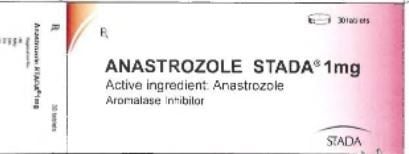This is an automatically translated article.
Anabrez is a drug commonly used in the treatment of breast cancer in postmenopausal women. In order for the use of drugs to be effective and safe, patients need to follow the instructions of the consulting doctor or pharmacist.1. What is Anabrez?
Anabrez is a medicine that contains the main ingredient Anastrozole 1mg. This active ingredient is known for its ability to inhibit the aromatase enzyme of the non-steroidal group, with high selectivity and rapid effect in a short time. In postmenopausal women, oestradiol is produced primarily from the conversion of androstenedione to estrogen, which is then converted to oestradiol.Many research papers have shown that reducing the amount of oestradiol in the blood will bring many benefits to breast cancer patients. Specifically, daily use of Anabrez has the potential to reduce oestradiol levels by more than 80% in postmenopausal patients.
2. Indications and contraindications for Anabrez
With the above effect, Anabrez is indicated for use in the treatment of breast cancer in postmenopausal women, especially women whose cancer has progressed even after taking Tamoxifen (Including Nolvadex, Soltamox).However, Anabrez is also contraindicated in some cases such as:
Pre-menopausal women or pregnant and lactating women. Patients with severe renal impairment (check creatinine clearance less than 20ml/min). People with moderate to severe liver disease. Hypersensitivity to Anastrozole or to any of the excipients of Anabrez.
3. Dosage and how to take Anabrez
Anabrez is recommended to use with a dose of 1 tablet per day.
No dose adjustment is required in patients with mild hepatic impairment or mild to moderate renal impairment.
4. Anabrez side effects
During the use of Anabrez, patients may experience some of the following side effects:
Effects on blood vessels: Appearance of mild or moderate hot flashes. Effects on the whole body: There are signs of weakness. Effects on the musculoskeletal system, connective tissue and bones: Pain or stiffness is felt. Effects on reproductive system and mammary glands: Decreased vaginal discharge. Effects on skin and subcutaneous tissue: thinning hair, hair loss, itchy rash. Effects on the digestive system: Nausea or diarrhea. Effects on the nervous system: Causes headaches, dizziness. Effects on digestion: Anorexia, hypercholesterolemia, vomiting. In addition to the common side effects, patients may also experience some rare side effects when taking Anabrez including:
Effects on the skin and subcutaneous tissue: Appearance of erythema multiforme, allergic reactions including Angioedema, urticaria, Steven-Johnson syndrome. Vaginal bleeding: Common in patients with advanced breast cancer during the first few weeks after switching from hormonal therapy to drug therapy.
5. Drug interactions
Anabrez should not be used concurrently with estrogen-containing therapies or Tamoxifen because it will reduce the effectiveness of the drug.
6. Precautions when using Anabrez
Anabrez should not be used in children because safety and efficacy have not been established in this patient population. Menopause should be determined by biochemical testing prior to use in patients with suspected endocrine status. Women with osteoporosis or with suspected osteoporosis should have their bone mineral density formally assessed before using Anabrez as well as at regular intervals thereafter. This is because the drug can reduce circulating estrogen levels leading to a decrease in bone mineral density. Above is some information about Anabrez drug that readers can refer to. The use of drugs should be strictly followed as prescribed by the doctor to maximize the effectiveness of breast cancer treatment, to avoid unwanted side effects.
Please dial HOTLINE for more information or register for an appointment HERE. Download MyVinmec app to make appointments faster and to manage your bookings easily.













